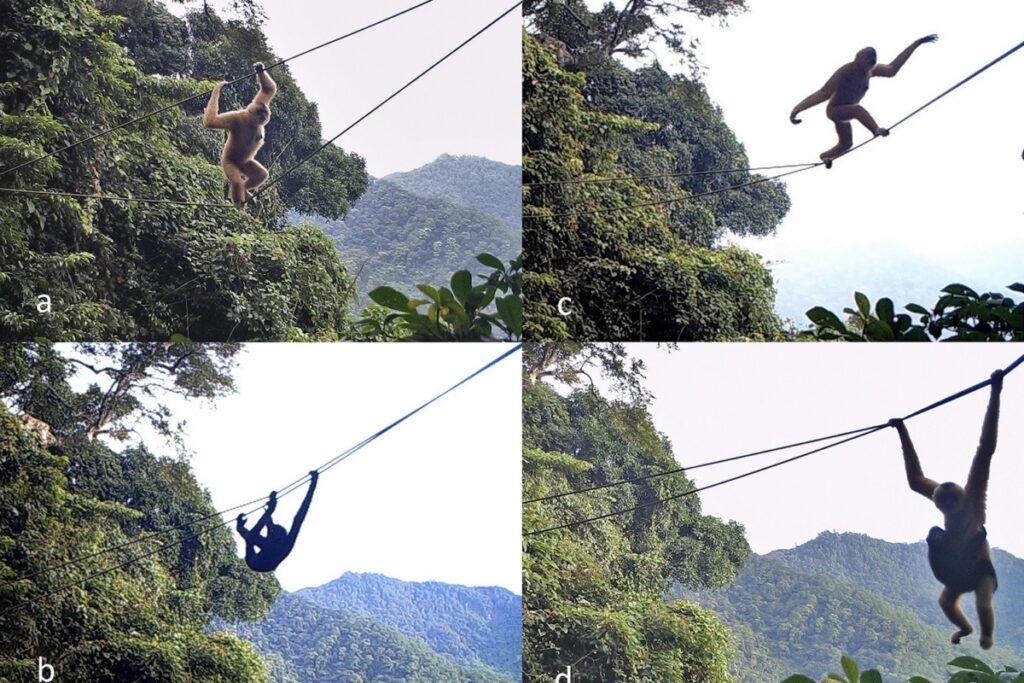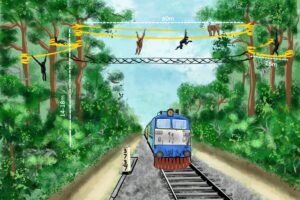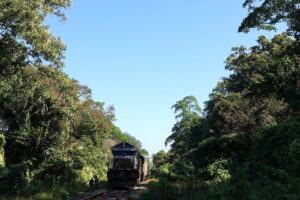Saving India’s Only Ape, The Hoolock Gibbon
Nov 24, 2023 | Pratirodh Bureau
The Hainan gibbon artificial canopy bridge example from China, based on which the present design for Western hoolock gibbon at Hollongapar Sanctuary has been suggested with additional design considerations such as safety nets below the rope-based bridges (Photo from Chan et al., 2012)
A report by scientists from the Wildlife Institute of India (WII) outlines how the endangered western hoolock gibbon population in Hollongapar Gibbon Sanctuary (HGS), Assam is fragmented because of a railway line running through the sanctuary. It makes recommendations on how the gibbon population can be preserved, in the wake of railway electrification and expansion plans.

As the only ape species in India, the hoolock gibbon (Hoolock hoolock) has been extensively studied and key threats include habitat loss and fragmentation, and hunting. In the current focus area at HGS, the gibbon population comprising 125 individuals (in 26 groups) inhabits an area that is fragmented by the Mariani-Dibrugarh railway line that is currently unelectrified.
Rohit Jha, senior project associate, Environmental Impact Assessment (EIA) Cell, WII and a member of the research team said, “The Lumding-Dibrugarh broad gauge railway section, of which the track within Hollongapar Gibbon Sanctuary is a part, is currently undergoing electrification, as part of the Indian Railways (IR) push towards a 2030 net zero emission target.”
The existing fragmentation coupled with plans to electrify and eventually double the track pose a serious threat to gibbons, a species that is primarily arboreal, which means they live in trees. In order to connect the two parts of the habitat, previous efforts have been taken by the North East Frontier Railway (NEFR) and the Assam State Forest Department (ASFD) to construct an artificial canopy bridge. The NGO Aaranyak and the ASFD have also made efforts to build a natural canopy bridge. While the artificial bridge has never been used by the gibbons, the natural bridge was used after several years of it being installed.
Despite these efforts, there is no proper connectivity between the fragmented habitat segments, as trees and branches are frequently trimmed by the NEFR to maintain the railway track. The WII report outlines installation of artificial canopy bridges at proposed locations to better facilitate gibbon movement across the habitat. Canopy bridges are an ideal way to conserve this species in particular, as gibbons rarely move on the ground since it makes them more susceptible to predation.
Locations were chosen through identification of appropriate trees based on height and girth. The guidelines developed for the design and installation of these canopy bridges also took into account the opinions of IR and other stakeholders.
“According to the team’s last discussion with the District Forest Officer (Territorial) Jorhat, the artificial canopy bridges may be installed during the next two months,” Jha added. “The Indian Railways through its NEFR Zone will execute and fund this in association with the Department of Environment and Forest, Government of Assam.”
The report further recommends that the railway track be rerouted so as to mitigate negative consequences for the biodiversity of HGS. In addition to the gibbon, the HGS is home to six other primate species, making it an area with the highest biodiversity of primate species of any Protected Area in the country.
Regarding the rerouting of the railway track, Jha said, “Our argument towards rerouting the track are multi-fold – a globally endangered canopy-dwelling species for whom conventional mitigation measures such as overpass and underpass will be infeasible, a very small and isolated (but biodiverse) protected area, a relatively small railway stretch (1.6 kilometre) to be affected, available non-forest land close by and existing linear infrastructure (both road and rail) where the realigned line could be bunched with.”
He added that they are pivoting this unique set of circumstances as an opportunity to the Indian state towards demonstrating its commitment and will for harmonising ecological well-being with infrastructure development. “This might incur additional cost to the Indian Railways by way of acquiring non-forest land, but this is the only viable long-term strategy to both facilitate increased rail traffic on the route (since track doubling is also planned in the near future) and ensure the ecological integrity of the Hollongapar Gibbon Sanctuary.”
If the Indian Railways were to agree to this recommendation, positive effects would extend well beyond the gibbons. “The rerouting will also potentially ameliorate wildlife collisions on the track of other fauna such as elephants and free the forest for unimpeded animal crossings”, he added.

“Over the longer term, rerouting the existing railway line must be accompanied with measures to connect the isolated Sanctuary with nearby Reserved Forests (to the south) through land purchases (potentially along the Bhogdoi River) and reforestation, alongside implementing other suggested conservation measures,” Jha told Mongabay-India.
The report also suggests monitoring of gibbon groups through behavioural data collection in addition to camera traps and perhaps even population and genetic studies to assess if such conservation measures are beneficial. For the behavioural data collection, it has been suggested to train local communities/forest rangers, in order to facilitate collection in a scientific manner.
“Since the Western hoolock gibbon is the flagship species of the Sanctuary, and since considerable research has been undertaken on the Sanctuary’s flora and fauna over the years, the local staff is quite well-versed and familiar with the behaviour of and monitoring all its primates,” Jha said.
“Utilising the strength of the well-versed and motivated senior departmental staff, a simple datasheet can be designed in the local language to collect data. It will be absolutely beneficial if a few motivated youth from the local community could be identified to jointly do this as well. Researchers/primatologists (from WII, Aaranyak, and other NGOs) will initially provide training to the monitoring team towards such systematic data collection, including installing/monitoring arboreal camera traps as well. While researchers/primatologists/DFO (T) Jorhat may generally oversee the data collection exercise, the idea is to let the execution part, including data curation and database maintenance, primarily rest with the Forest Department,” Jha concludes.
Given that Assam has shown exemplary conservation initiatives to protect species such as the one-horned rhino, it is promising that the ASFD and state government have begun the process of installing artificial canopy bridges to conserve the hoolock gibbon and other arboreal species.
(Published under Creative Commons from Mongabay-India. Read the original article here)
